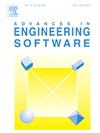Stochastic vibration prediction of long-span bridges under traffic load based on deep neural network of multi-mode information fusion
IF 5.7
2区 工程技术
Q2 COMPUTER SCIENCE, INTERDISCIPLINARY APPLICATIONS
引用次数: 0
Abstract
The accuracy prediction of the bridge response is crucial in the structural health monitoring and safety assessment of long-span bridges under vehicular loads. Hence, a novel method based on multi-mode information fusion for stochastic vibration prediction of long-span bridges is proposed in this study. Specifically, the dynamic equations for the random vehicle-bridge interaction system in the state-space form are deduced to provide a theoretical basis and physical guidance for the proposed method. On this basis, a surrogate model consisting of a variational mode decomposition and long short-term memory networks is developed for vibration prediction of bridges. In particular, the variational mode decomposition can be employed to extract the vibration mode information of the bridge in multi-frequency bands, which significantly improves the time-series analysis capability of the long short-term memory networks. The accuracy and robustness of the proposed method are verified by a numerical case and real bridge field measurements. The results show that the maximum prediction error of the proposed method is <4 %.
基于多模信息融合深度神经网络的交通荷载下大跨度桥梁随机振动预测
在车辆荷载作用下的大跨度桥梁结构健康监测和安全评价中,桥梁响应的准确预测至关重要。为此,本文提出了一种基于多模态信息融合的大跨度桥梁随机振动预测方法。具体而言,推导了车辆-桥梁随机相互作用系统状态空间形式的动力学方程,为该方法提供了理论依据和物理指导。在此基础上,建立了由变分模态分解和长短期记忆网络组成的桥梁振动预测代理模型。其中,变分模态分解可以提取桥梁多频段的振动模态信息,显著提高了长短期记忆网络的时间序列分析能力。数值算例和桥梁现场实测结果验证了该方法的准确性和鲁棒性。结果表明,该方法的最大预测误差为4%。
本文章由计算机程序翻译,如有差异,请以英文原文为准。
求助全文
约1分钟内获得全文
求助全文
来源期刊

Advances in Engineering Software
工程技术-计算机:跨学科应用
CiteScore
7.70
自引率
4.20%
发文量
169
审稿时长
37 days
期刊介绍:
The objective of this journal is to communicate recent and projected advances in computer-based engineering techniques. The fields covered include mechanical, aerospace, civil and environmental engineering, with an emphasis on research and development leading to practical problem-solving.
The scope of the journal includes:
• Innovative computational strategies and numerical algorithms for large-scale engineering problems
• Analysis and simulation techniques and systems
• Model and mesh generation
• Control of the accuracy, stability and efficiency of computational process
• Exploitation of new computing environments (eg distributed hetergeneous and collaborative computing)
• Advanced visualization techniques, virtual environments and prototyping
• Applications of AI, knowledge-based systems, computational intelligence, including fuzzy logic, neural networks and evolutionary computations
• Application of object-oriented technology to engineering problems
• Intelligent human computer interfaces
• Design automation, multidisciplinary design and optimization
• CAD, CAE and integrated process and product development systems
• Quality and reliability.
 求助内容:
求助内容: 应助结果提醒方式:
应助结果提醒方式:


